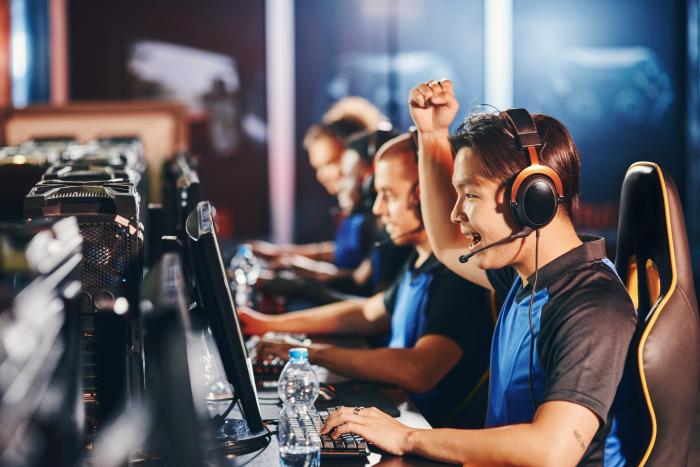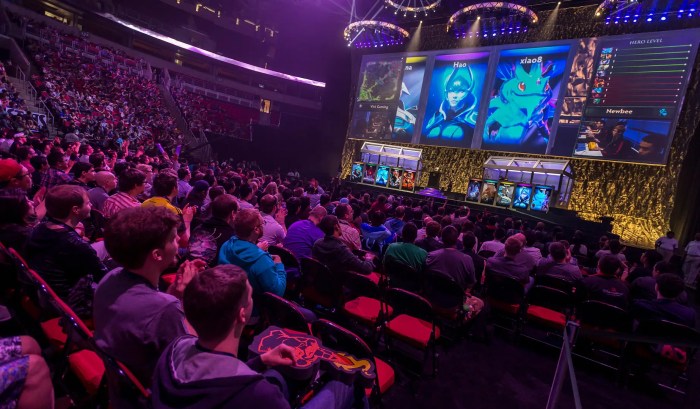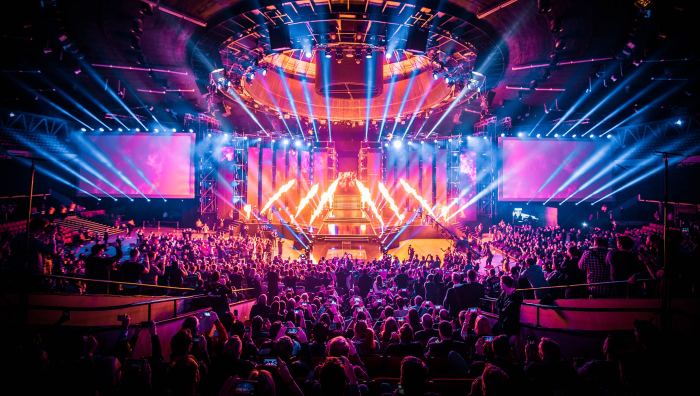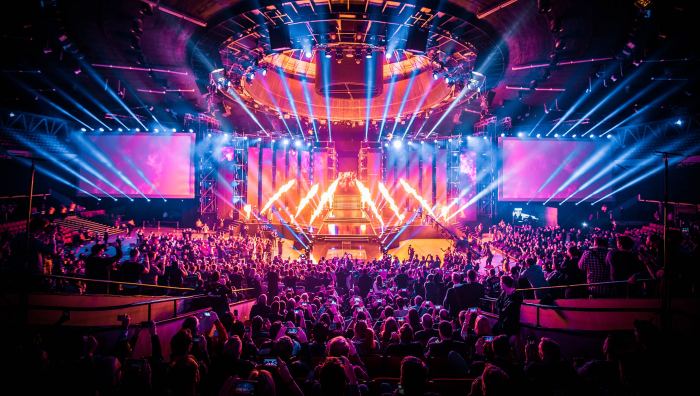Competitive Gaming has exploded from basement LAN parties to massive, globally televised esports leagues. It’s a multi-billion dollar industry fueled by passionate players, dedicated teams, and innovative technology. This exploration dives into the history, business, and future of this thrilling phenomenon, examining everything from the evolution of gameplay to the complex dynamics of the competitive scene.
We’ll trace the journey from early arcade tournaments to the sophisticated esports organizations of today, highlighting key moments and technological advancements that shaped the industry. We’ll also look at the business side of things, exploring revenue streams, stakeholder roles, and successful (and unsuccessful!) business models. Finally, we’ll delve into the future of competitive gaming, considering emerging trends and potential challenges.
History of Competitive Gaming

Competitive gaming, or esports, has exploded in popularity, transforming from niche hobby to a global phenomenon. Its journey, marked by technological leaps and evolving community dynamics, reflects the broader history of video games themselves. This evolution showcases how simple arcade challenges grew into the highly organized, professionally-funded leagues we see today.
Early competitive gaming was largely defined by local arcade tournaments. Players would gather, often anonymously, to compete for bragging rights and sometimes small cash prizes. Games like Pac-Man, Donkey Kong, and Street Fighter II became the battlegrounds for these early competitions, fostering a sense of community among players who shared a passion for pushing their skills to the limit.
The rise of the internet was pivotal, allowing for broader competition and the formation of online communities. This period saw the emergence of early online gaming communities, often centered around specific games and fostering intense rivalries and collaboration.
The Rise of Online Competition and Early Esports
The advent of online multiplayer gaming dramatically altered the landscape. Dial-up connections, initially slow and unreliable, gave way to broadband internet, enabling smoother, more competitive gameplay. Games like StarCraft and Quake became early cornerstones of online esports, with players gaining fame and recognition through online tournaments and leagues. This period saw the rise of prominent players who became early pioneers and legends of the competitive scene.
The emergence of online platforms specifically designed for competitive gaming further fueled this growth.
Technological Advancements and Professionalization
Several technological advancements significantly impacted the development of esports. High-speed internet, improved game engines allowing for more complex and balanced gameplay, and streaming platforms like Twitch and YouTube Gaming were crucial. These platforms allowed for a wider audience to watch and engage with esports, driving both player interest and sponsorship opportunities. The improvement in graphics cards and processors made high-quality, fast-paced gameplay possible, which further enhanced the spectator experience.
The Modern Esports Landscape
The modern esports scene is vastly different from its humble beginnings. Professional teams are backed by significant sponsorships, with players earning substantial salaries and competing for substantial prize pools. Dedicated arenas host large-scale tournaments with thousands of spectators, and media coverage has grown exponentially. While the early gaming communities were largely organic and self-organized, the current scene is a highly structured and commercialized industry, with dedicated leagues, managers, coaches, and analysts playing vital roles.
Timeline of Major Milestones
A concise timeline helps illustrate the significant moments that shaped competitive gaming’s trajectory:
| Year | Milestone |
|---|---|
| 1970s-1980s | Early arcade tournaments and local competitions. |
| 1990s | Rise of online gaming and early esports titles (e.g., StarCraft, Quake). |
| 2000s | Growth of online communities and organized tournaments; increasing media attention. |
| 2010s | Esports explodes in popularity; professional leagues and teams emerge; significant sponsorship and investment. |
| 2020s | Esports becomes a mainstream entertainment phenomenon; global expansion and diverse game titles. |
The Business of Esports: Competitive Gaming

Esports has exploded from a niche hobby to a multi-billion dollar industry, attracting massive audiences, significant investment, and global recognition. Understanding the business model behind this growth is crucial to appreciating its impact and future potential. This section explores the diverse revenue streams, key stakeholders, and strategic approaches shaping the competitive gaming landscape.Esports revenue generation is multifaceted, relying on a complex interplay of different income streams and stakeholders.
The success of any esports organization hinges on its ability to effectively leverage these avenues and manage the relationships between its various components.
Revenue Streams in Competitive Gaming
The financial success of esports relies on a variety of revenue streams, each contributing significantly to the overall profitability of the industry. These streams are interconnected and often mutually reinforcing, creating a robust ecosystem.
- Sponsorships: Brands leverage the large and engaged esports audience to promote their products and services. These sponsorships can range from team jerseys and arena branding to integrated product placements within broadcasts. For example, energy drink companies frequently sponsor esports teams and tournaments, associating their brands with the energy and excitement of competitive gaming.
- Advertising: Esports events and online broadcasts offer lucrative advertising opportunities. Pre-roll ads, mid-roll ads, and banner ads are common, generating revenue based on impressions and clicks. The high viewership of major esports tournaments makes this a particularly attractive advertising space.
- Merchandise: Teams and individual players often sell branded merchandise, including apparel, accessories, and collectibles. This direct-to-consumer sales model allows for a more intimate connection with fans and provides a consistent revenue stream independent of tournament performance.
- Media Rights: The broadcasting rights to major esports tournaments are a significant revenue source. Streaming platforms like Twitch and YouTube, as well as traditional television networks, compete to secure these rights, paying substantial fees for exclusive access to the content. The sale of these rights contributes heavily to the overall profitability of tournament organizers.
Roles of Stakeholders in the Esports Ecosystem
The esports industry thrives on the collaboration and competition of various stakeholders, each playing a critical role in the overall success of the ecosystem.
- Game Developers: They create the games that fuel the esports industry. Their involvement extends beyond game creation; they often participate in tournament organization, sponsorship deals, and the development of in-game features designed to enhance the spectator experience.
- Tournament Organizers: These entities plan, execute, and manage esports competitions, securing sponsorships, negotiating media rights, and handling logistics. They are central to the industry’s structure, creating the events that drive viewership and revenue.
- Teams: Professional esports teams recruit, train, and manage players. They act as brands, negotiating sponsorships, managing player contracts, and building fan bases. Successful teams build strong brands and generate revenue through sponsorships and merchandise.
- Players: The heart of the industry, professional esports players compete at the highest level, attracting viewers and sponsors. Their skill and performance are directly linked to the success of teams and the overall industry’s popularity. Successful players can earn substantial salaries and endorsements.
Hypothetical Business Model for a New Esports Organization
A new esports organization focused on a growing mobile MOBA (Multiplayer Online Battle Arena) title could adopt a multi-pronged approach. This organization, “Phoenix Esports,” would focus on building a strong brand through social media engagement, securing sponsorships from mobile gaming accessory companies and energy drink brands targeting young adults, and creating engaging content for platforms like YouTube and TikTok.
Revenue streams would include sponsorship deals, merchandise sales (through a dedicated online store), and participation in tournaments and leagues, aiming for a mix of revenue sources to mitigate risk and maximize profit potential.
Examples of Successful and Unsuccessful Business Strategies
The esports industry provides numerous examples of both successful and unsuccessful business strategies. Team Liquid’s diverse portfolio of teams across multiple game titles, coupled with their strong brand identity and community engagement, exemplifies a successful approach. Conversely, organizations that over-extend financially or fail to adapt to evolving game popularity and audience preferences often struggle to remain competitive, highlighting the importance of strategic planning and adaptability.
The failure of some early esports organizations serves as a cautionary tale of the need for sustainable business models and a deep understanding of the market.
Game Genres in Competitive Gaming
Competitive gaming, or esports, boasts a diverse landscape of genres, each with its unique appeal and strategic depth. The popularity of a genre often hinges on factors like accessibility, spectator appeal, and the inherent complexity of its gameplay. While many genres exist, some consistently dominate the professional scene due to their captivating blend of skill, strategy, and excitement.The most popular genres in competitive gaming showcase a fascinating contrast in gameplay mechanics and competitive strategies.
First-person shooters (FPS) emphasize individual skill and quick reflexes, while Multiplayer Online Battle Arenas (MOBAs) require intricate team coordination and strategic macro-gameplay. Fighting games demand precise execution and mastery of character-specific techniques, and real-time strategy (RTS) games necessitate meticulous resource management and tactical foresight. This diversity contributes to the overall richness and breadth of the esports ecosystem.
First-Person Shooters (FPS), Competitive Gaming
FPS games like
Counter-Strike
Global Offensive* (CS:GO) and
Valorant* have reigned supreme in competitive gaming for years. Their appeal lies in the fast-paced action, precise aiming, and strategic team play. Competitive strategies in FPS often revolve around map control, tactical maneuvers, and individual gun skill. Teams develop intricate strategies for bomb defusal/planting (CS
GO) or spike planting/defusal (Valorant), coordinating their movements and utilizing specific agents or weapons to gain an advantage. The high skill ceiling and the potential for dramatic, clutch moments keep viewers engaged.
Multiplayer Online Battle Arenas (MOBAs)
MOBAs, exemplified by
- League of Legends* and
- Dota 2*, are known for their complex gameplay and high strategic depth. These games demand a deep understanding of individual character roles, team compositions, and map awareness. Competitive strategies in MOBAs involve meticulous laning phases, objective control, and coordinated team fights. Successful teams demonstrate exceptional macro-gameplay, managing resources, pushing lanes, and adapting to their opponents’ strategies. The long matches and intricate team dynamics create a compelling narrative for spectators.
Fighting Games
Fighting games, such as
- Street Fighter V* and
- Tekken 7*, demand exceptional precision and reaction time. The focus is on mastering character-specific move sets, executing complex combos, and reading your opponent’s actions. Competitive strategies often involve exploiting character matchups, predicting opponent actions, and utilizing neutral game strategies to control space and dictate the flow of the match. The high skill ceiling and the potential for thrilling comebacks make fighting games highly engaging to watch.
Comparison of Competitive Game Genres
| Genre | Gameplay Focus | Competitive Strategies | Spectator Appeal |
|---|---|---|---|
| First-Person Shooter (FPS) | Individual skill, aiming, quick reflexes, team coordination | Map control, tactical maneuvers, weapon selection, team communication | Fast-paced action, clutch moments, individual highlights |
| Multiplayer Online Battle Arena (MOBA) | Teamwork, strategic macro-gameplay, resource management, character roles | Objective control, team composition, laning phase strategy, coordinated team fights | Intricate team dynamics, long-term strategic planning, comeback potential |
| Fighting Game | Precision, reaction time, character mastery, execution of combos | Character matchups, neutral game, predicting opponent actions, exploiting weaknesses | High skill ceiling, thrilling comebacks, individual player expression |
The Players and Teams

The world of competitive gaming, or esports, isn’t just about the games themselves; it’s about the highly skilled individuals and well-organized teams that dedicate their lives to mastering them. These athletes undergo rigorous training, face intense pressure, and navigate complex team dynamics to achieve victory. Their success hinges on a combination of raw talent, strategic thinking, and unwavering dedication.Professional competitive gamers lead demanding lives, far removed from the casual gaming experience.
Their days often involve hours of practice, strategic analysis, and physical conditioning.
Training Regimes and Lifestyle
Professional gamers’ training is intense and highly structured. A typical day might include several hours of gameplay focused on specific aspects of the game, such as map awareness, aim training, or team coordination. This is often supplemented by physical exercise to maintain stamina and reaction time, as well as mental exercises to enhance focus and concentration. Many professional players also incorporate dietary plans to maintain peak physical and mental performance.
Sleep schedules are meticulously planned to ensure adequate rest, crucial for maintaining performance and preventing burnout. This disciplined lifestyle is essential for maintaining a competitive edge in the constantly evolving world of esports.
Roles and Responsibilities Within Esports Teams
Esports teams are not simply collections of skilled players; they are well-oiled machines with distinct roles and responsibilities. While players are the core of the team, executing strategies during matches, other roles are equally crucial for success. Coaches analyze opponents’ strategies, develop training plans, and provide in-game guidance. Managers handle logistical aspects, including sponsorships, contracts, travel arrangements, and team communication.
Analysts delve into match data to identify strengths and weaknesses, helping the team refine their strategies. The success of a team relies heavily on the seamless collaboration between all these roles.
Psychological and Physical Demands
Competitive gaming demands significant psychological resilience. Players face immense pressure during high-stakes matches, dealing with potential failure and intense scrutiny from fans and critics. The ability to manage stress, maintain focus under pressure, and bounce back from setbacks is critical. Physical demands are also substantial. Prolonged periods of sitting can lead to physical strain, requiring players to maintain good posture and incorporate regular breaks and stretching.
Eye strain, carpal tunnel syndrome, and other repetitive strain injuries are also common concerns, necessitating proactive health management. Mental health is another crucial aspect, with professional teams often providing access to therapists or counselors to support players’ well-being.
Profile of a Successful Competitive Gaming Team
Consider a hypothetical team, “Apex Predators,” dominating the
Counter-Strike
Global Offensive* (CS:GO) scene. Their success stems from a combination of factors. They boast exceptional individual skills, with players specializing in specific roles like entry-fragging, support, and AWPing. Their strategic depth is evident in their map pool and ability to adapt to different opponents’ styles. The team’s coach meticulously analyzes opponents’ strategies, identifying weaknesses and tailoring their approach accordingly.
Their strong team chemistry, built through years of playing together, allows for seamless coordination and communication during matches. Their achievements include multiple tournament victories, a high ranking in global leaderboards, and lucrative sponsorship deals, demonstrating the potential for success in professional esports. Their consistent performance and adaptability highlight the importance of both individual skill and cohesive team dynamics in achieving sustained success.
The Impact of Technology

Esports wouldn’t be the global phenomenon it is today without the significant advancements in technology that have fueled its growth and evolution. From the platforms that connect players and viewers to the sophisticated tools that analyze performance, technology has been the driving force behind esports’ explosive popularity and professionalization. This section will explore the multifaceted impact of technology on competitive gaming.Streaming platforms and social media have fundamentally reshaped how esports are consumed and experienced.
The accessibility offered by platforms like Twitch and YouTube has democratized access to competitive gaming, allowing anyone with an internet connection to watch professional matches, follow their favorite teams, and engage with the broader esports community. Social media, meanwhile, acts as a crucial communication channel, fostering fan engagement, building brand loyalty, and providing a space for players and teams to interact directly with their audiences.
This constant connection fuels the growth of the esports ecosystem, creating a self-reinforcing cycle of engagement and viewership.
Streaming Platforms and Social Media’s Role in Esports Growth
The rise of Twitch and YouTube Gaming has been instrumental in the exponential growth of esports viewership. These platforms provide a readily available and engaging platform for broadcasting live matches, player streams, and behind-the-scenes content. The interactive nature of these platforms, featuring live chat and community features, fosters a sense of community and connection among viewers, enhancing the overall viewing experience.
Furthermore, social media platforms like Twitter, Instagram, and Facebook serve as critical marketing and communication tools, allowing esports organizations to reach wider audiences and build brand awareness. The ability to share highlights, interact with fans, and build hype for upcoming events significantly impacts the growth and reach of esports. For example, the viral nature of highlight reels on platforms like TikTok has exposed esports to entirely new audiences, showcasing the skill and excitement of competitive gaming to a broader demographic.
Advancements in Gaming Hardware and Software
Technological advancements in gaming hardware and software have directly influenced gameplay and competition. Higher frame rates, improved graphics, and reduced input lag create a more responsive and immersive gaming experience, allowing players to react more quickly and precisely. The development of more powerful processors and graphics cards enables the creation of more complex and visually stunning games, pushing the boundaries of what’s possible in competitive gaming.
This translates to more nuanced gameplay strategies and a higher skill ceiling, driving the evolution of competitive play. For instance, the introduction of high-refresh-rate monitors has significantly impacted competitive shooters, allowing professional players to gain a competitive edge through faster reaction times. Similarly, advancements in game engines have enabled developers to create more balanced and feature-rich competitive games.
Data Analytics and Performance Tracking in Competitive Gaming
Data analytics and performance tracking are now integral parts of professional esports. Teams and organizations utilize sophisticated software and tools to collect and analyze vast amounts of data on player performance, team strategies, and opponent tendencies. This data-driven approach allows coaches and analysts to identify areas for improvement, optimize strategies, and gain a competitive advantage. Advanced metrics such as kill-death ratios, average damage per round, and map control percentages are meticulously tracked and analyzed to inform strategic decisions and player development.
This sophisticated data analysis is similar to the techniques used in professional sports, highlighting the increasing professionalization of esports. The use of heatmaps visualizing player movement and engagement on the map provides valuable insights into player positioning and strategic decision-making.
Innovative Technologies Enhancing the Spectator Experience
Esports organizers are constantly exploring innovative technologies to enhance the spectator experience. Virtual reality (VR) and augmented reality (AR) offer immersive viewing options, allowing fans to feel more connected to the action. The use of drone cameras and other advanced camera systems provides unique and dynamic perspectives of the gameplay, creating a more engaging viewing experience. Interactive elements, such as virtual cheering sections and personalized overlays, allow viewers to participate more actively in the event.
For example, some esports events utilize holographic displays to create immersive environments, further enhancing the spectator experience. The integration of advanced analytics and real-time data visualization during broadcasts provides viewers with a deeper understanding of the strategic aspects of the game, enriching their engagement with the competition.
Popular Questions
How much money can professional gamers make?
Earnings vary wildly, from a few thousand dollars a year to millions for top players in popular titles. It depends on skill, team success, sponsorships, and streaming revenue.
What are the health risks associated with competitive gaming?
Prolonged gaming can lead to repetitive strain injuries, eye strain, sleep deprivation, and other health issues. Professional players often have strict training regimens to mitigate these risks.
How do I get started in competitive gaming?
Start by identifying a game you enjoy and practicing consistently. Join online communities, participate in smaller tournaments, and gradually work your way up the ranks. Networking is key!
What are some popular competitive games right now?
Popular titles constantly evolve, but current heavy hitters include League of Legends, Dota 2, Counter-Strike: Global Offensive, Valorant, and various fighting games like Street Fighter and Tekken.
